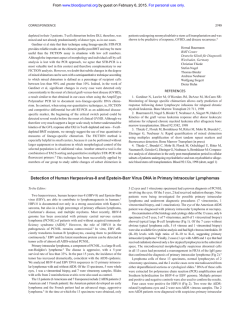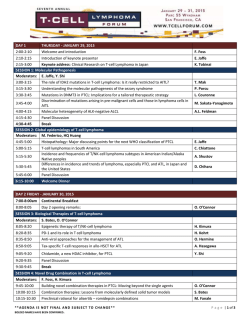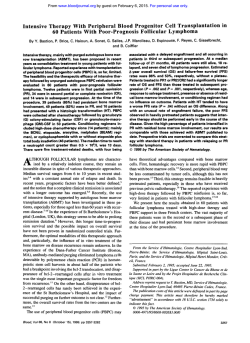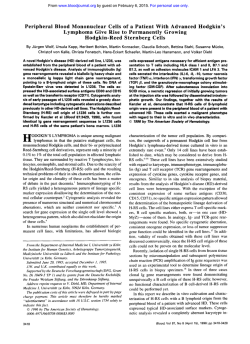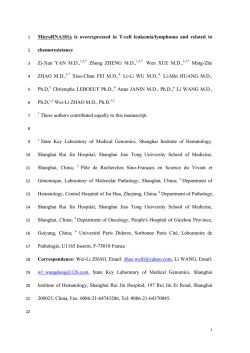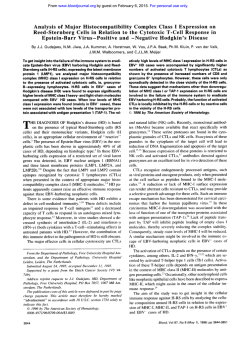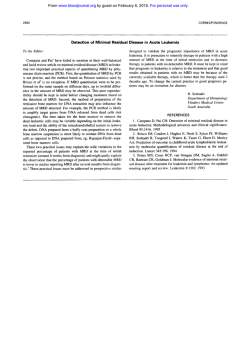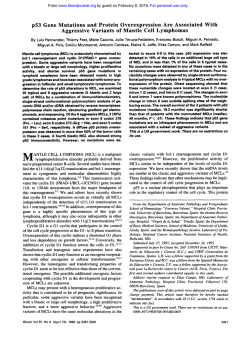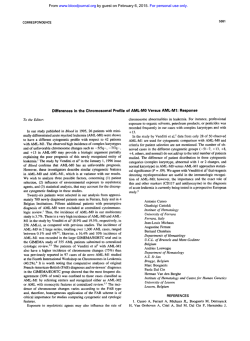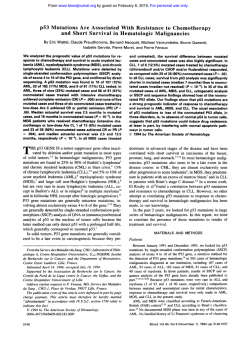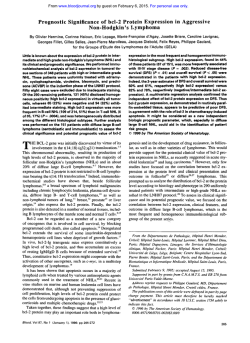
Rearrangements of the BCL-6 Gene in Acquired
From www.bloodjournal.org by guest on February 6, 2015. For personal use only. RAPID COMMUNICATION Rearrangements of the BCL-6 Gene in Acquired Immunodeficiency Syndrome-Associated Non-Hodgkin's Lymphoma: Association With Diffuse Large-Cell Subtype By Gianluca Gaidano, Francesco Lo Coco, Bihui H. Ye, Darryl Shibata, Alexandra M. Levine, Daniel M. Knowles, and Riccardo Dalla-Favera Acquired immunodeficiency syndrome (AIDS)-associated non-Hodgkin's lymphomas (AIDS-NHL), a major source of morbidity and m o r t a l i i among AIDS patients, are derived from B cells and can be classified into two main histologic categories, m a l l noncleaved cell lymphoma (SNCCL) and diffuse large-cell lymphoma (DLCL). DLCL includes two histologic subsets, ie, large noncleavedcell lymphoma (LNCCL) and large cell-immunoblastic plasmacytoid lymphoma (LCIBPL). Several studies have shown that AIDSSNCCL is associated with the clonal accumulation of multiple genetic lesions, including Epstein-Barrvirus (EBV) infection, activation of the c-MYC and M S oncogenes, as well as inactivation of the p53 tumor suppressor geneat variable froquencies. On the contrary, the molecular pathogenesis of AIDS-DLCL is largely obscure, because no genetic lesion other than EBV infection has been specifically identified in this group. In this N ON-HODGKIN'S lymphomas (NHL) represent one of the most common malignancies associated with hu) and are recogman immunodeficiency virus ( W infection, nized as an acquired immunodeficiency syndrome (AIDS)defining ~ondition."~ Since their initial observation in 1982: the incidence of AIDS-associated NHL (AIDS-NHL) has been consistently increasing,'.' and they now represent the most frequent HIV-associated malignancy in some AIDS risk groups, namely, the hemophiliacs.' Indeed, some estimates project that 10% to 20% of all new NHL cases in the United States may eventually be related to A I D S 6 AIDS-NHL are almost invariably B-cell-derived NHL.'.2.7"' When compared with NHL of similar histology arising in the immunocompetent host, AIDS-NHL display distinctive clinical features, including late stage at presentation, poor prognosis, and the frequent involvement of extranodal site^.'^'^^"* Systemic AIDS-NHL are histologically heterogeneous, and have been initially classified into three distinct categories, including small noncleaved cell lymphoma (SNCCL), large noncleaved cell lymphoma (LNCCL), and large cell-immunoblastic plasmacytoid lymphoma (LC-IBPL).7*9Subsequently, most investigators have agreed to classify LNCCL and LC-IBPL as a single category under the term of diffuse large-cell lymphoma (DLCL).I3 Some progress has been made in elucidating the molecular pathogenesis of AIDS-SNCCL."3 We and others have shown that AIDS-SNCCL is associated at variable frequency with multiple genetic lesions, including Epstein-Barr virus (EBV) infection, c-MYC translocation, RAS gene family mutation, and p53 inactivation by point mutation and allelic ~oss~l.3.14-26 On the other hand, the pathogenesis of AIDSDLCL is relatively less defined. EBV infection appears to be the only genetic lesion associated with a significant fraction of these tumors, particularly with the subset displaying plasmacytoid features; p53 lesions have not been found Blood, Vol 84, No 2 (July 15). 1994 pp 397-402 study, we havetested a panelof 40 AIDS-NHL for structural alterations of BCL-6, a putative proto-oncogene that is frequently altered in DLCL in the immunocompetent host. Our results show that rearrangements of BCL-6 are present in 20% of AIDS-DLCL (5 of 241, including 2 of 8 LNCCL and 3 of 16 LC-IBPL, butinno case of AIDS-SNCCL.BCL-6 rearrangements were detected both in the presence and in the absence of EBV infection of the tumor clone, but inno case were associatedwith activation of c-MYC or mutations of p53. These data identify a novel genetic lesion in AIDSDLCL and corroborate the notion that lymphomagenesis in AIDS follows two distinct molecular pathways that are associated with thedevelopment of histologically distinct types Of AIDS-NHL. 8 1994 by The American Society of Hematology. and c-MYC activation is restricted to a small minority of cases.l-3.14-26 Recently, rearrangements of the BCL-6 gene, located on 3q27 and coding for a putative zinc finger transcription factor, have been identified as a recurrent genetic lesion of DLCL in the immunocompetent h ~ s t . ' ~ -The ~ ' same gene has ~ the name also been called LAZ-33'73' or B c 1 5 - 5 , ~although BCL-5 had already been assigned to a locus on 17q2234and the name BCL-6 has been officially adopted.34 Rearrangements of BCL-6 result in truncation within 5' noncoding regulatory sequences and occur in 30% to 40% of DLCL.'8 Cytogenetic analysis has suggested that breakpoints at 3q27, the site of BCL-6, may occur also in AIDS-DLCL,35 although the exact frequency has not been determined and the involvement of BCL-6 has not been documented. These observations have prompted our analysis of BCL-6 reFrom the Divisions of Oncology and Surgical Pathology, Department of Pathology, College of Physicians and Surgeons, Columbia University, New York, N Y ; and the Departments of Pathology and Hematology, University of Southern California School of Medicine, Los Angeles, CA. Submitted December 27, 1993; accepted April 19, 1994. Supported by National Institutes of Health Grants No. CA-37295 (to R.D.-F.) and CA-48236 (to D.M.K.). G.G. has been supported by a Fellowship for AIDS research from Istituto Superiore di Sanith, Rome, Italy. F.L.C. has been supported by Associazione Italiana contro le Leucemie, Rome, Italy. Address reprint requests to Riccardo Dalla-Favera,MD, Division of Oncology, Department of Pathology, College of Physicians and Surgeons. Columbia University, 630 W 168th St, New York, NY 10032. The publication costs of this article were defrayed in part by page charge payment. This article must therefore be hereby marked "adverrisement" in accordance with 18 U.S.C. section 1734 solely to indicate this fact. 0 1994 by The American Society of Hematology. oooS-4971/94/8402-0037$3.00/0 397 From www.bloodjournal.org by guest on February 6, 2015. For personal use only. 398 arrangements in apanel of AIDS-NHL representative of both the SNCCL and DLCL subtypes. We wished to define the frequency of BCL-6 involvement in AIDS-NHL andto correlate its presence with other genetic lesions that have been described in the pathogenesis of AIDS-NHL. GAIDANO ET AL (Sac4.0) and restriction enzymes (BumHI and Xba I) that, in combination, explore a region of 15.2 kb containing the 5' portion of the BCL-6 gene2'v3' (Fig 1). This same region was previously shownto contain the cluster of chromosomal breakpoints detected inNHLoftheimmunocompetent Cases showing an abnormallymigratingband in only one digest were further studied by hybridizingthe MATERIALS ANDMETHODS Sac4.0 probe to additional digests (Bgl 11) or, alternatively, Pathologic samples. Biopsy samples of lymph node, bone marby hybridizing BamHI and Xbu I digests to a probe (SacO.8) row, peripheral blood, or other involved organs from 40 patients derived from the BCL-6 first intron, which, being located 3' with AIDS were collected during the course of standard diagnostic procedures. Thirty-two samples were derived from patients referred of the breakpoint cluster, explores the reciprocal chromoto the Department of Pathology, New York University (New York, some 3 (Fig 1). Only cases showing abnormally migrating N Y ) or to the Department of Pathology, Columbia University (New bands with two restriction enzymes andor two probes were York, NY) and their histology was reviewed by D.M.K. Eight samscored as rearranged. ples were derived from patients referred to the Departments of HeRearrangements of BCL-6 were detected in5 of 24 AIDSmatology and Pathology, University of Southern California School DLCL (20.8%), both in the LNCCL (2 of 8; 25%) and in of Medicine (Los Angeles, CA) and their histology was reviewed the LC-IBPL (3 of 16; 18.7%) variants (Table 1 and Fig 1). by D.S. Diagnosis was based on analysis of histopathology, immunoAll cases of AIDS-SNCCLand CD30+ lymphomas disphenotypic analysis of cell surface markers, and immunogenotypic playedagermline BCL-6 locus (Table 1and Fig 1). The analysis of Ig gene rearrange men^^^ In most cases, the fraction of location of the breakpoints detected in AIDS-NHL corremalignant cells in the pathologic specimen was greater than 80%. sponds to the pattern most commonly observed in DLCL of as determined by cell suspension cytofluorometric or tissue section immunohistochemical analysis of cell surface markers andby Ig immunocompetent the (Fig 1). gene rearrangement analysis. Other genetic lesions. The other genetic lesions investiDNA extraction andSouthern blot analysis. DNA was purified gated in the panel of AIDS-MIL included infection by EBV by digestion with proteinase K, "salting out" extraction, and precipiof the tumor clone, activation of the c-MYC and RAS prototation by ethanol.37For Southern blot analysis:' 6 pg of DNA was oncogenes,and inactivation ofthe p53 tumor suppressor digested with the appropriate restriction endonuclease, electrophogene. The experimental strategies used to investigate these resed in a 0.8% agarose gel, denatured, neutralized, transferred to lesions have been described in detail e l s e ~ h e r e . ' ~ *For '~.~ Duralon filters (Stratagene, La Jolla, CA), and hybridized to probes some of the cases, the molecular characterization of these that had been "P-labeled by the random primer extension method.39 genetic lesions had been previously r e p o ~ t e d ' ~ *for ' ~ *the ~~; Filters were washed in0.2X SSC (NaCI/Na citrate)/0.5% sodium other cases, it has been assessed in the course of this study. dodecyl sulphate (SDS) for 2 hours at60°Cand then autoradiographed using intensifying screens (Quanta 111; Dupont, Boston, EBV infection was assessed by Southern blot hybridizaMA). tion using a probe representative of the EBV termini42 that DNA probes. Ig gene rearrangement analysis was performed usallows us to analyze clonality in EBV-infected tissuesz4(Fig ing a JH probe4' (a gift of Dr S.J. Korsmeyer) on HindIII, EcoRI, 2). A monoclonal infection was detected in 5 of 13 (38%) and B m H I digests. The organization of the BCL-6 locus was investiSNCCL, 17 of 24 DLCL (71%) (3 of 8 [37.5%] LNCCL gated by hybridization of Xba I, BamHI-, and Bgl 11-digested DNA and 14 of 16 [87.5%] LC-IBPL), and 3 of 3 (100%) CD30' to the human BCL-6 probe Sa~4.0.~'.~' In selected cases, a second cases. probe representative of the BCL-6 locus, SacO.8, was also used. The Rearrangements ofc-MYC were tested by hybridizing organization of the c-MYC locus was analyzed by hybridization HindIII- and EcoRI-digested DNAs with a probe representaof EcoRI- and HindIII-digested DNA to the human c-MYC probe tive of c-MYCexon 34'(Fig 2). Rearrangementswere present MC413RC. representative of the third exon of the c-MYC gene?' The presence of the EBV genome was investigated with a probe in 13 of 13 SNCCL (loo%),5 of 24 (20.8%) DLCL (2 of specific for the EBV termini (5.2-kb BamHI-EcoRI fragment isolated 8 [25%] LNCCL and 3 of 16 [18.7%] LC-IBPL), and 2 Of from the fused BamHI terminal fragment NJ-het).42 3 CD30+ cases. Mutations of p53 and RAS were analyzed by a two-step RESULTS strategy. Single-strand conformation polymorphism (SSCP) analysis was applied to p53 exons 5 through 9 (in 29 cases) Forty cases of systemic AIDS-NHL were studied, includor p53 exons 5 through 8 (in 6 cases) (Fig 2) and to N-, ing 13 SNCCL and 24 DLCL (8 LNCCL and 16 LC-IBPL). K-, and H-RAS exons l and 2 (in 29 cases); cases displaying In addition, 3 cases of CD30+ lymphomas, which have been an altered electrophoretic pattern by SSCP were further studsporadically reported in were also included. All cases displayed a predominant monoclonal B-cell population ied byDNA direct sequencing of the PCR product. p53 mutations were scored in 8 of 13 (61.5%) SNCCL, but in as determined by Ig gene rearrangement analysis (data not none of the DLCL tested (0 of 22). Finally, RAS activation shown). by point mutation was positive in 3 of 13 (23%) SNCCL Analysis of BCL-6 rearrangements. The BCL-6 gene and in 1 of 16 (6%) DLCL tested. contains at least 9 exons spanning approximately 26 kb of The molecular features of the cases displaying BCL-6 regenomic DNA.28Sequence analysis has shown that the first arrangements are listed in Table 2. Overall, BCL-6 reexon is noncoding and that the translation initiation codon arrangements were detected both in the presence and in the is located within the third exon.28Rearrangements of BCLabsence of clonal EBV infection of the tumor, whereas C6 can be detected by Southern blot analysis using a probe From www.bloodjournal.org by guest on February 6, 2015. For personal use only. BCL-6 REARRANGEMENTS IN AIDS-ASSOCIATED NHL A 399 C B 14 Kb 11.4 Kb -- - 14 Kb RE BumHI XbUI Probe XbuI Sac4.0 Sac4.O Sac0.8 D 11.40 l I 14 Kb l l B X B Sac4.0 X SacO.8 - ' 5 5 1 3 Fig 1. Analysis of BCL-6rearrangements in AIDS-NHL (A, B, and C) and restriction mapof the germlineBCL-6 locus (D). (A, B, and C1 DNAs were digestedwith B e d l (A) or Xba I (B and C) and hybridizedt o probes Sac4.0 (A and B) or Sac0.8 IC). The BCL-6 germline bands detected by B a d 1 (11.4 kb) and Xba I ( l 4 kb) are indicated. U937 was used as a BCL-6 germline control. Among the cases shown, rearrangements were detected in cases DK782, DK827, and DS16, represented by AIDS-DLCL. (D) Exon-intron organization of the BCL-6 gene. Coding and noncoding exons are represented by solid and open boxes, respectively. The transcription initiation site has not bean mapped (shaded box on 5' side of first exon). The breakpoints detected in AIDS-NHL are indicated by arrows. Restriction enzyme symbols are S, Sac I; B, 6 a d I ; X, Xba I; R, €&I. RE, restriction enzyme. MYC alterations and p53 mutations were consistently absent in the cases displaying BCL-6 rearrangements. DISCUSSION DLCL represents the most frequent type of AIDS-NHL in the HIV-infected adult.8 Despite its epidemiologic relevance, the molecular pathogenesis of these tumors is largely ~nclarified.~ In this study, we report a novel genetic lesion in AIDS-NHL that appears to be restricted to the AIDSDLCL histologic type. Our analysis of the genomic configuration of BCL-6 in a panel of AIDS-NHL indicates that BCL-6 rearrangements are involved in approximately 20% of AIDS-DLCL, whereas they are consistently negative in AIDS-SNCCL. In this respect, BCL-6 rearrangements may be considered the first identified genetic lesion specific for the DLCL type among AIDS-NHL. BCL-6 rearrangements are present in both subgroups of DLCL, ie,LNCCL and LCIBPL, and occur both in the absence and in the presence of EBV infection of the tumor clone (Table 2). On the other hand, BCL-6 rearrangements were never detected in AIDSDLCL carrying c-MYC alterations (Table 2). Future studies of larger series of cases will clarify whether these two genetic From www.bloodjournal.org by guest on February 6, 2015. For personal use only. GAIDANO ET AL 400 Table 2. Molecular Features of AIDS-DLCL Table 1. Frequency of 6CL-6 Rearrangements in AIDS-NHL DLCL' SNCCL LNCCL 0113311 CD30' N H L t LC-IBPL 218 6 013 The DLCL included in thepanel can be further distinguished into two subgroups (LNCCL and LC-IBPL), as previously reported?' t NHL expressing the CD30 cell surface antigen.u lesions represent mutually exclusive events in the pathogenesis of AIDS-DLCL. These data are consistent with a model of AIDS-lymphomagenesis that suggests that genetically distinct pathways are specifically associated with different histologic types of AIDS-NHL.'.I4 The molecular pathway leading to AIDSSNCCL involves c-MYC rearrangements, p53 mutations, and EBV infection in loo%, 60%, and 40% of the cases, respectively.3.14-26 The presence of somatic hypermutation in the Ig variable regions used by AIDS-SNCCL points to chronic antigen stimulation as an additional mechanism in the development of these tumors."6 The second genetic pathway is associated with AIDS-DLCL and involves EBV in the large majority of cases, as well as c-MYC andlor BCL-6rearrangements in a fraction of case^.'^-*^ These distinct pathogenetic mechanisms correlate with a number of clinical features that distinguish AIDS-SNCCL from AIDS-DLCL, including different age at onset and different CD4 counts at the time of lymphoma development.'.'.* Although the number of AIDS-DLCL studied is presently kb 239.4 6.6 kb 23 1 - 2.0 - Clonality LNCCL LNCCL LNCCL LNCCL LNCCL LNCCL LNCCL LNCCL + DK771 DK827 DS16 DK3537 DK3357 DK63 DK1446 DK3479 DK2092 DS17 DS45 DS46 DS93 DS136 DS155 DS165 LC-IBPL LC-IBPL LC-IBPL LC-IBPL LC-IBPL LC-IBPL LC-IBPL LC-IBPL LC-IBPL LC-IBPL LC-IBPL LC-IBPL LC-IBPL LC-IBPL LC-IBPL LC-IBPL BCL-6 EBV c-MYC p53 RAS - + + + - + - + + + + + + + + + + + + - + + + + + + + + + - + - + + ND + + + + + + + + + + + The results of the analysis of EBV, c-MYC, p53, and RAS of some of these cases have been previously rep~rted.".'~.'~ Abbreviation: ND, not done. - 4.4 23 - 9.4 4.4 2.3- Histology DK782 DK1178 DK1028 DK3973 DK773 RDF834 DK1452 DK64 C B A Patient No. 6.6 fc 2.0 - Fig 2. Analpis ofEBV infection (A), c-MYCrearrangements (B), and p53mutations(C) in AIDS-NHL. (A) Analysis of EBV termini heterogeneity in AIDS-NHL. DNAs were digested with BamHl and subjected t o Southern hybridization usinga DNA probe specific for the fused termini of the EBV genome.u U937, a monocytic leukemia cell line, is used as a negative control.A lymphoblastoid cell linederived by EBV infection of normal polyclonal B cells (NC2) is used as control for polymorphicEBV termini. Representative samples of AIDS-NHL, both positive (DK3794, DK4338, DK2814, and DK3973) and negative(DK3479). are shown. (B) Southern blot analysis of c-MYC rearrangements in AIDS-NHL. Genomic DNAs from the cases shown was digested with Hindlll and probedwith clone MC413RC." representative of c-MYCexon 3. A lymphoblastoid cases shown, t w o cases of AIDS-DLCL (DK3537 and DK1446) cell line(NC2) was used as control forc-MYC germline configuration. Among the display a c-MYC rearrangement. (C) Analysis by PCR-SSCP of the p53 gene in AIDS-NHL. Representative examples are shown for p53 exon 5. Samples were scored as abnormal when differing from the normal control (NI. A sample known t o harbor a p53 mutation wasused as positive control (POS). Among the cases shown, DK1171, a case of AIDS-SNCCL, shows a p53 mutation that was further characterized by direct sequencing of the PCR product. From www.bloodjournal.org by guest on February 6, 2015. For personal use only. BCL-6 REARRANGEMENTS IN AIDS-ASSOCIATED NHL 401 American classification of lymphoid neoplasms: A proposal from limited, our results suggest that the frequency of BCL-6 rethe International Lymphoma Study Group. Blood (in press) arrangements in AIDS-DLCL is significantly lower than that 14. Ballerini P, Gaidano G , Gong JZ, Tassi V, Saglio G, Knowles in DLCL in the immunocompetent host, where BCL-6 reDM, Dalla-Favera R. Multiple genetic lesions in acquired immunoarrangements occur in more than 40% of the cases.3oIt is deficiency syndrome-related non-Hodgkin’s lymphoma. Blood possible that the genetic pathogenesis of these two groups 81:166, 1993 of tumors is different, and that the molecular mechanisms 15. Gaidano G, Parsa NZ, Tassi V, Della-Latta P, Chaganti RSK, active in AIDS-DLCL are characterized by a higher degree Knowles DM, Dalla-Favera R: In vitro establishment of AIDS-reof heterogeneity. Among DLCL in the immunocompetent lated lymphoma cell lines: Phenotypic characterization, oncogene host, BCL-6 rearrangements are associated with distinct clinand tumor suppressor gene lesions, and heterogeneity in EpsteinBarr virus infection. Leukemia 7:1621, 1993 ical features, including the extranodal origin of the 16. Groopman JE, Sullivan JL, Mulder C, Ginsburg D, Orkin SH, lymphoma and the lack of bone marrow i n ~ o l v e m e n tIn .~~ O’Hara CJ, Falchuk K, Wong-Staal F, Gallo RC: Pathogenesis of addition, the presence of this rearrangement appears to repreB-cell lymphoma in a patient with AIDS. Blood 67:612, 1986 sent a favorable prognostic m ~ k e r . Future 4~ studies are war17. Pelicci P-G, Knowles DM, Arlin Z A , Wieczorek R, Luciw ranted to determine whether BCL-6 rearrangements are assoP, Dina D, Basilic0 C, Dalla-Favera R Multiple monoclonal B cell ciated with distinctive clinical features in AIDS-NHL as expansions and c-myconcogene rearrangements in acquired immune well. deficiency syndrome-related lymphoproliferative disorders. Implica- REFERENCES 1. Karp JE, Broder S : Acquired immunodeficiency syndrome and non-Hodgkin’s lymphomas. Cancer Res 51:4743, 1991 2. Levine AM: Acquired immunodeficiency syndrome-related lymphoma. Blood 80:8, 1992 3. Gaidano G, Dalla-Favera R: Biologic aspects of human immunodeficiency virus-related lymphoma. Cum Opin Oncol 4:900, 1992 4. Ziegler JL, Drew WL, Miner RC, Mintz L, Rosenbaum E, Gershow J, Lennette ET, Greenspan J, Shillitoe E, Beckstead J, Casavant C, Yamamoto K: Outbreak of Burkitt’s like lymphoma in homosexual men. Lancet 2:631, 1982 5. Ragni MV, Belle SH, Jaffe RA, Duerstein SL, Bass DC, McMillan CW, Lovrien EW, Aledort LM, Kisker CT, Stabler SP, Hoots WK, Hilgartner MW, Cox-Gill J, Buchanan GR, Sanders N L , Brettler DB, Barron LE, Goldsmith JC, Ewenstein B, Smith KJ, Green D, Addiego J, Kingsley LA: Acquired immunodeficiency syndrome-associated non-Hodgkin’s lymphomas and other malignancies in patients with hemophilia. Blood 81:1889, 1993 6. Gail MH, Pluda JM, Rabkin CS, Biggar RI, Goedert JJ, Horm JW, Sondik ET, Yarchoan R, Broder S : Projection of the incidence of non-Hodgkin’s lymphoma related to acquired immunodeficiency syndrome. J Natl Cancer Inst 83:965, 1991 7. Raphael BC, Knowles DM: Acquired immunodeficiency syndrome-associated lymphomas. Semin Oncol 17:361, 1990 8. Beral V, Peterman T, Berkelman F, Jaffe H: AIDS-associated non-Hodgkin lymphoma. Lancet 337:805, 1991 9. Knowles DM, Chamulak CA, Subar M, Burke JS, Dugan M, Wernz J, Slywotzky C, Pelicci P-G, Dalla-Favera R, Raphael B: Lymphoid neoplasia associated with the acquired immunodeficiency syndrome (AIDS). Ann Intern Med 108:744, 1988 10. Levine AM, Meyer PR, Begandy MK, Parker JW, Taylor CR, Irwin L,Lukes RJ: Development of B-cell lymphoma in homosexual men. Ann Intern Med 100:7, 1984 11. Carbone A, Tirelli U, Vaccher E, Volpe R, Gloghini A, Bertola G, De Re V, Rossi C, Boiocchi M, Monfardini S : A clinicopathologic study of lymphoid neoplasias associated with human immunodeficiency virus infection in Italy. Cancer 68:842, 1991 12. Ioachim HL, Dorsett B, Cronin W, Maya M, Wahl S : Acquired immunodeficiency syndrome-associated lymphomas: Clinical, pathologic, immunologic, and viral characteristics of 111 cases. Hum Pathol 22:659, 1991 13. Harris N L , Jaffe ES, Stein H, Banks PM, Chan JKC, Cleary M, Delsol G, De Wolf-Peters C, Falini B, Gatter KC, Grogan T, Isaacson PC, Knowles DM, Mason DY, Muller-Hermelink H-K, Pileri SA, Pins MA, Raltlciaer E,Warmke RA: A revised European- tions for lymphomagenesis. J Exp Med 164:2049, 1986 18. Subar M, Neri A, Inghirami G, Knowles DM, Dalla-Favera R: Frequent c-myc oncogene activation and infrequent presence of Epstein-Barr Virus genome in AIDS-associated lymphoma. Blood 72:667, 1988 19. Haluska FG, Russo G, Kant J, Andreef, Croce CM: Molecular resemblance of an AIDS-associated lymphoma and endemic Burkitt lymphomas: Implications for their pathogenesis. Proc Natl Acad Sci USA 86:8907, 1989 20. Meeker TC, Shiramizu B, Kaplan L, Herndier B, Sanchez H, Grimaldi JC, Baumgartner J, Rachlin J, Feigal E, Rosenblum M, McGrath MS: Evidence for molecular subtypes of HIV-associated lymphoma: Division into peripheral monoclonal, polyclonal and central nervous system lymphoma. AIDS 5:669, 1991 21. Epstein-Barr virus and AIDS associated lymphomas. Editorial. Lancet 338:979, 1991 22. Hamilton-Dutoit SJ, Delecluse HJ, Raphael M, Lenoir G, Pallesen G: Detection of Epstein-Barr virus genomes in AIDS related lymphomas: Sensitivity and specificity of in situ hybridization compared with Southern blotting. J Clin Pathol44:676, 1991 23. Hamilton-Dutoit SJ, Pallesen G, Franzmann MB, Karkov J, Black F, Skinh0j P, Pedersen C: AIDS-related lymphoma. Histopathology, immunophenotype, and association with Epstein-Barr virus as demonstrated by in situ nucleic acid hybridization. Am J Pathol 138:149, 1991 24. Neri A, Baniga F, Inghirami G, Knowles DM, Neequaye J, Magrath IT, Dalla-Favera R: Epstein-Barr virus infection precedes clonal expansion in Burkitt’s and acquired immunodeficiency syndrome-associated lymphoma. Blood 77:1092, 1991 25. Nakamura H, Said J W , Miller CW, Koeffler HP: Mutation and protein expression of p53 in acquired immunodeficiency syndromerelated lymphomas. Blood 82:920, 1993 26. Carbone A, Tirelli U, Gloghini A, Volpe R, Boiocchi M: Human immunodeficiency virus-associated systemic lymphomas may be subdivided into two main groups according to Epstein-Barr viral latent gene expression. J Clin Oncol 1:1674, 1993 27. Ye BH, Rao PH, Chaganti RSK, Dalla-Favera R: Cloning of BCL-6, the locus involved in chromosome translocations affecting band 3q27 in B-cell lymphoma. Cancer Res 53:2732, 1993 28. Ye BH, Lista F, Lo Coco F, Knowles DM, Offit K, Chaganti RSK, Dalla-Favera R. Alterations of a zinc finger-encoding gene, BCL-6, in diffuse large cell-lymphoma. Science 262:747, 1993 29. Baron BW, Nucifora G, McCabe N. Espinosa R 111, Le Beau MM, McKeithan T W : Identification of the gene associated with the recurring chromosomal translocations t(3; 14)(q27;q32) and t(3;22)(q27;qll) in B-cell lymphomas. Proc Natl Acad Sci USA 905262, 1993 From www.bloodjournal.org by guest on February 6, 2015. For personal use only. 402 30. Lo Coco F, Ye BH, Lista F, Corradini P, Offit K, Knowles DM, Chaganti RSK, Dalla-Favera R Rearrangements of the BCL6 gene in diffuse large-cell non-Hodgkin lymphoma. Blood 83: 1757, 1994 31. Kerckaert J-P, Deweindt C, Tilly H,Quief S, Lecocq G, Bastard C: LAZ3, a novel zinc-finger encoding gene, is disrupted by recurring chromosome 3q27 translocations in human lymphoma. Nature Genet 5:66, 1993 32. Deweindt C, Kerckaert J-P, Tilly H, Quief S, Nguyen VC, Bastard C: Cloning ofa breakpoint cluster region at band 3q27 involved in human non-Hodgkin’s lymphoma. Genes Chromosom Cancer 8:149, 1993 33. Miki T, Kawamata N, Hirosawa S, Aoki N: Gene involved in the 3q27 translocation associated with B-cell lymphoma, BCL-5, encodes a Kruppel-like Zinc-finger protein. Blood 83:26, 1994 34. McAlpine PJ, Shows TB, Povey S , Canitt B, Pericak-Vance MA, Boucheix C, Anderson WA, White JA: The 1993 Catalog of Approved Genes and Report of the Nomenclature Committee, in Cuticchia AJ, Pearson PL (eds): Human Gene Mapping. Baltimore, MD, Johns Hopkins, 1994, p 6 35. Bastard C, Tilly H: Response to letter “t(2;3)(q12;q27) in Hodgkin’s disease of a human immunodeficiency-virus positive patient with hemophilia,” by Schlegelberger B, Grote W, Wacker HH, Bartels H. Blood 81:265, 1993 (letter) 36. Knowles DM, Pelicci P-G, Dalla-Favera R: T-cell receptor Beta chain (TB) gene rearrangements: Genetic markers of T-cell lineage and clonality. Hum Path01 17:546, 1986 37. Miller SA, Dykes DD, Polesky H F A simple salting out procedure for extracting DNA from human nucleated cells. Nucleic Acid Res 16:1215, 1988 38. Sambrook J, Fritsch E, Maniatis T: Molecular Cloning: A Laboratory Manual. Cold Spring Harbor, NY, Cold Spring Harbor Laboratory, 1989 39. Feinberg AP, Vogelstein B: A technique for radiolabeling GAIDANO ET AL DNA restriction endonuclease fragments to high specific activity. Anal Biochem 132:6, 1983 40. Korsmeyer SJ, Hyeter PA, Revetch JV, Poplack DG, Waldmann TA, Leder P Developmental hierarchy of immunoglobulin gene rearrangement in human leukemic pre-B cells. Proc Natl Acad Sci USA 78:7096, 1981 41. Dalla-Favera R, Bregni M, Erikson J, Patterson D, Gallo RC, Croce CM: Human c-myc oncogene is located on the region of chromosome 8 that is translocated in Burkitt lymphoma cells. Roc Natl Acad Sci USA 79:7824, 1982 42. Weiss LM, Srickler J, Wamke R, Purtilo DT, Sklar J: EpsteinBarr virus DNA in tissues of Hodgkin’s disease. Am J Pathol 129:86, 1987 43. Chadburn A, Cesarman E, Jagirdar J, Subar M, Mir RN, Knowles DM: CD30 (Ki-l) positive anaplastic large cell lymphomas in individuals infected with the human immunodeficiencyvirus. Cancer 72:3078, 1993 44. Gaidano G , Ballerini P, Gong JZ, Inghirami G, Neri A, Newcomb EW, Magrath IT, Knowles DM, Dalla-Favera R: p53 mutations in human lymphoid malignancies: Association with Burkitt lymphoma and chronic lymphocytic leukemia. Proc Natl Acad Sci USA 88:5413, 1991 45. Shibata D, Weiss LM, Hernandez AM, Nathwani BN, Bemstein L, Levine AM: Epstein-Barr virus associated non-Hodgkin’s lymphoma in patients infected with the human immunodeficiency virus. Blood 81:2102, 1993 46. Riboldi P, Gaidano G, Schettino EW, Steger TG, Knowles DM, Dalla-Favera R, Casali P: Two acquired immunodeficiency syndrome-associated Burkitt’s lymphomas produce specific anti-i IgM cold agglutinins using somatically mutated V&-21 segments. Blood 83:2952, 1994 47. Offit K, Lo Coco F, Louie DC, Parsa NZ, Leong D, Ye BH, Lista F, Filippa DA, Rosenbaum A, Ladanyi M, Dalla-Favera R, Chaganti RSK: Rearrangement of BCL-6 gene as a prognostic marker in large cell lymphoma. N Engl J Med (in press) From www.bloodjournal.org by guest on February 6, 2015. For personal use only. 1994 84: 397-402 Rearrangements of the BCL-6 gene in acquired immunodeficiency syndrome- associated non-Hodgkin's lymphoma: association with diffuse large-cell subtype G Gaidano, F Lo Coco, BH Ye, D Shibata, AM Levine, DM Knowles and R Dalla-Favera Updated information and services can be found at: http://www.bloodjournal.org/content/84/2/397.full.html Articles on similar topics can be found in the following Blood collections Information about reproducing this article in parts or in its entirety may be found online at: http://www.bloodjournal.org/site/misc/rights.xhtml#repub_requests Information about ordering reprints may be found online at: http://www.bloodjournal.org/site/misc/rights.xhtml#reprints Information about subscriptions and ASH membership may be found online at: http://www.bloodjournal.org/site/subscriptions/index.xhtml Blood (print ISSN 0006-4971, online ISSN 1528-0020), is published weekly by the American Society of Hematology, 2021 L St, NW, Suite 900, Washington DC 20036. Copyright 2011 by The American Society of Hematology; all rights reserved.
© Copyright 2025
